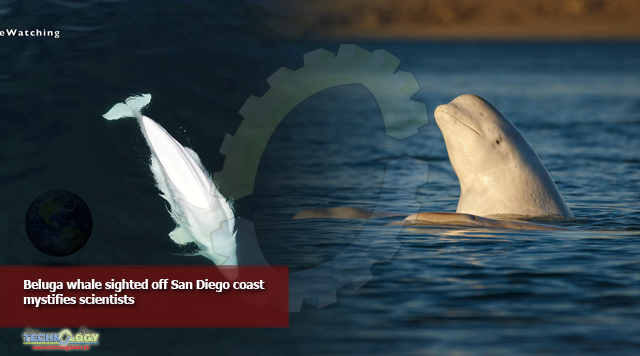It was a balmy Friday morning in June when Domenic Biagini, whale-watching tour captain and wildlife photographer, steered his 25-foot boat out of San Diego’s Mission Bay with six clients on board. The plan was to find some Beluga whale —perhaps a migrating blue whale—so he radioed Lisa LaPointe, another tour captain, to see if she’d seen any that day.

By Domenic Biagini
“Dom, we just saw a pearly white, 15-foot animal that didn’t have a dorsal fin,” he recalls her saying over the radio. “This is the pearliest white you can imagine.”
It definitely wasn’t a blue whale. Or a humpback or an orca, or any of the other species he usually sees while out on a whale-watching trip. What she was describing sounded like a beluga whale, but those aren’t supposed to be found anywhere near California waters.
An hour later, LaPointe radioed Biagini again, insisting that what she had seen really was a beluga. “Nobody’s going to believe us if we don’t have undeniable proof,” Lapointe told Biagini, urging him to help document what she saw. He navigated to her location so he could use his drone to film the animal.
Biagini searched for 45 minutes before the whale surfaced just 200 yards off his bow. “Undeniably, unmistakably, a beluga whale popped up in front of me,” he says. “It was so bizarre, that moment was so astonishing” that he immediately switched into “citizen scientist” mode, his hands shaking as he piloted his drone to document the surprise visitor.
Beluga whales typically restrict themselves to the Arctic and sub-Arctic waters off the coasts of Canada, Greenland, Russia, Scandinavia, and Alaska. They’re also highly social animals who often swim in pods. But the beluga whale that Biagini filmed on June 26 was some 2,500 miles from the nearest known beluga population, in Alaska, and it was all alone.
It’s the farthest south this species has ever been officially recorded. Questions about where it came from, and why, have left scientists scratching their heads.
Cetacean exploration
While uncommon, it isn’t unheard of for belugas to venture away from their polar habitat. In the spring of 1940, a beluga was spotted off the coast of Washington State. In the Atlantic, they’ve been seen as far south as Massachusetts and New Jersey, while belugas from Russian populations have been spotted as far south as Japan. And in 2018, a beluga nicknamed Benny found himself in the Thames River swimming toward London.
Still, it’s surprising for a beluga to turn up in Southern California. In recent years, those waters have seen an increasing number of unexpected species, but they’re typically visiting from the warmer tropics, such as yellow-bellied sea snakes and hammerhead sharks driven north by a combination of climate change and El Niño.
It’s not known what inspired this creature to set off on such an unexpected journey. Maybe “it decided to go on a road trip and it’s extra curious, or it could be sick and disoriented,” says Alisa Schulman-Janiger, a research associate at the Natural History Museum of Los Angeles.
Based on Biagini’s drone footage, however, she and other experts say the animal looks to have good body condition. As a generalist predator, it would have no problem finding enough to eat, even if the Californian menu looks a little different than it does back home. “I’d like to think that it’s on a grand adventure,” she says.
A long, strange trip
Without genetic information or a photo that can be matched to existing catalogues of belugas from Russia or Alaska, “where this whale came from is anybody’s guess. It could be from a number of different places,” says Kristin Laidre, a principal scientist at the University of Washington’s Polar Science Center.
The closest beluga population resides year-round in the Gulf of Alaska, with fewer than 300 in the Cook Inlet and another 20 in Yakutat Bay to the east. Globally, beluga whales are not considered threatened, but the Cook Inlet population, which includes the Yakutat whales, is classified as endangered under the U.S. Endangered Species Act, with an average annual decline of about 2.3 percent.
Also unusual, this beluga was alone. “Belugas are gregarious, they’re usually together in groups. To have one individual so far away from the core range of the beluga—I can’t even wager a guess why it swam to California,” Laidre says.
Several days after LaPointe and Biagini saw the whale, it turned up farther north, near California’s Channel Islands off the coast of Los Angeles, according to unconfirmed reports. If it really is the beluga, that would indicate that it’s turned around and may be slowly making its way back home.
Schulman-Janiger, who organizes annual grey whale counts in the area and participates in operations to disentangle whales from fishing gear, has what she calls an “informal sighting network” up and down the Pacific coastline.
She’s asked everyone to keep their eyes open for the lone white whale, but the last potential sighting was on June 30 near the Channel Islands. If the whale continues undetected, we will likely never know where it came from—or why.
Originally published at msn